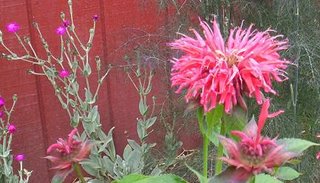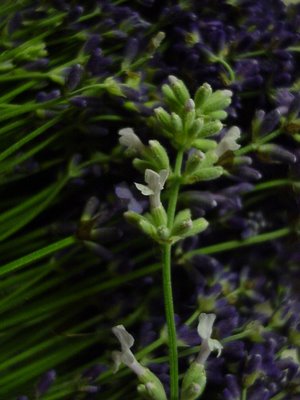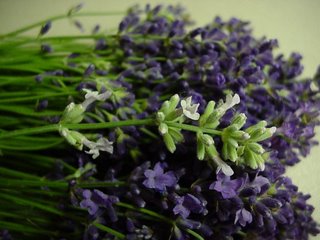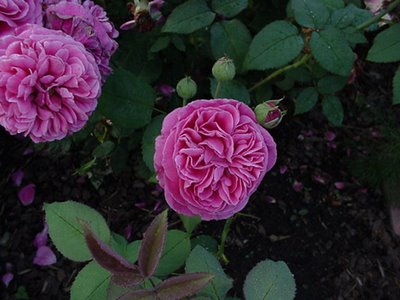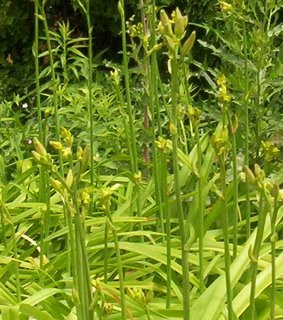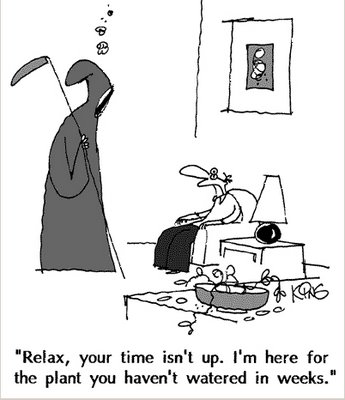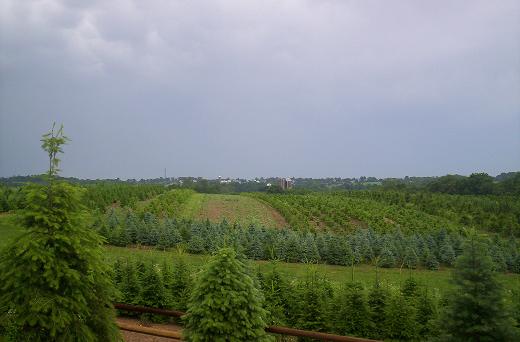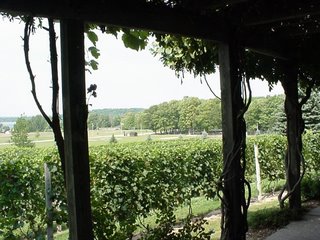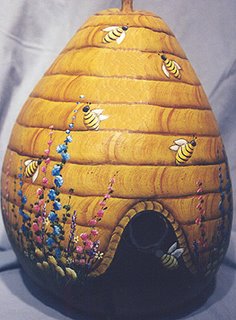Here are some odds and ends of information about hummingbirds that I collected over the years from various bulletin boards and mailing lists...
(March 2002 From Liz on the Front Porch @ Yahoo)

Put a banana peel out to attract flies and other insect near feeders. Hummers need protein as well as nectar. Especially when they have young to feed. The rotting banana peel gives them a wonderful source of insects. I don't put all the peel out at one time. I cut it up into pieces which we keep in the freezer till a new one is needed.
Sounds gross but works.
Also do not take down any spider webs next to your feeders. The mommy hummers get tiny gnats for their young from the webs.
So far as attracting migrating hummers, use wide red ribbon on branches of trees near feeders. You can also put the ribbons on poles around the feeders. The fluttering of the ribbons helps attract them. Did not believe this till we tried it, wow, we got hummers. Had moved into this house and felt the hummers would not know where the feeders were. We put red ribbon streamers about 2 feet long from the branches of the pine tree. They found that one first. Also tied it to clothes line where one feeder was hanging, also the satellite dish. The next year we put out more feeders with the ribbon near the new feeder. The old hummers came to the unmarked feeders and new hummers came to the new feeders with ribbon. We have as many as 10-12 feeders on the half acre of land.
Some people use "surveyor's tape" available in hardware stores. Supposedly the hummers like ultraviolet light, which the tape reflects.
Check migration charts on hummingbirds. This can be done on:
www.hummingbird.net
This site also has interesting information on hummingbird moths.
My recommendation is not to buy nectar either in dry or wet form. It is so simple to make your own. There is no need to make the nectar red to attract hummers. DO NOT USE FOOD COLORING IN NECTAR!!! Also do not make the home made nectar strong than 1 part sugar to 4 parts water - it is not healthy for the hummers.
Another hint is not to put much nectar in each feeder. This will not waste as much and there will be less cleaning with the liquid not going as high into the feeder. We generally do not go through more than about 2 oz. per changing.
My personal favorite hummer feeder is No. 203-CP of Perky Pet: it is 8 oz. glass feeder with bee guards and perches. We also use the little plastic tube feeders that have no perch and one feeder. We use about 8 of these during the summer. They are easier to clean the the perky glass feeders. We use a nylon scrubber with handle that has a scouring pad on the end to clean the little tubes. Some people use them to clean glasses or glass coffee pots.
Under no circumstance is detergent or soap to be used. If there is a great deal of mold use a weak solution of bleach, let sit over night, but rinse thoroughly.
Remember to clean feeders twice a week no matter of cool temperatures. Sometimes as often as ever other day in very hot weather. When the nectar begins looking weird, a thin film inside feeder, clean feeder.
Have never seen a drunk hummer so don't know if it ferments till the alcohol level goes up or just till it spoils.
The hummers like feeding in cool areas during the summer. They prefer shade because they can spot other hummers and can give chase quickly. Looking into the sun does not aid them in watching for intruding hummers. Also nectar gets much too warm during the summer. Having the feeder in the shade, there will not be the expansion and contraction which causes the nectar to leak.
To ward off ants that will invade the feeders use ant traps with bakers non stick spray on inside of trap. Or put water in ant trap. The water can be drunk by other birds so the spray is more preferred. When it rains the spray causes a film on the top of the water. The ant trap needs to be kept clean of dead bugs and debris.
Always put the feeders out at least two weeks before they arrive. Many of them travel through and are not seen feeding while going further north. They eat and run.
You can tell the fledgelings from the mature birds. The young ones do not know how to perch. Usually be the end of summer they are beginning to learn.
Hummers also like to eat from the Oriole feeders. They do not weigh enough to make the bracket go down, but they still can get they tongue in there to sip.
Here is a list of some of the flowers that will help provide hummers with natural nectar.
Annuals:
Beard Tongue (and other penstemons)
Fire Spike
Fuchsia
Impatiens
Jacobiana
Jewelweed
Petunia
Red Salvia
Scarlet Sage
Shrimp Plant
Perennials:
Bee Balm (Monarda)
Canna
Cardinal Flower
Columbine
Four-O-Clocks
Hosta
Little Cigar
Lupine
Penstemon
Yucca
(Ym-health's Note: Hummingbirds always show up here when the coral bells first bloom, also crabapple trees.)
Trees or Shrubs:
Azalea
Flowering Quince
Lantana
Manzanita
Mimosa
Red Buckeye (these are large trees, and feed dozens of birds at once in
the early spring.)
Turk's Cap
Weigela
Vines:
Coral Honeysuckle
Cypress Vine
Morning Glory
Trumpet Creeper
Remember that hummers can not smell so they are drawn by the flower color.
Also wild flowers not hybrids produce the most nectar.
Here is the site for the hummers: wwww.hummers.net
Over on the right hand side of the home page is the migration map site. Click on it and this year's site will come up. You can also pick another year to compare when they arrived previous years.
Last year they were a week earlier. I put my feeders out a couple weeks before they are supposed to arrive here because some are going north who need to feed. Once in a while they will get them north of here before we get ours that stay all summer. So we get the visitors who just "eat and run". This is also why during the first couple of weeks when your hummers come back there seem to be so many of them. There are travelers who will stay just long enough to gather so fat to go further north. The males ALWAYS come north first. They have to find food sources before the females arrive.
Then all summer long it is a constant battle of those possessive males to keep the females away from the feeders. This year we are putting some of the feeders down by the front window below where the male can spot the female. She goes below the front window inbetween the shrubs and window and flies slowly over to the feeder. When she sees him off chasing another male she pops up and drinks. This year there are going
to be so many feeders all over that he is going to be doing nothing but chasing. Ha! If I put the feeders at least twenty feet apart and about eight of them he is not going to be able to protect them all. He sits on this one bare branch. He thinks he can see both feeders on the front side of the house. On the backside of the tree where he can't watch we have another small feeder. Behind the pine tree is another. Across the street at the mail box is another. The yucca plant by the blossom stem
is one. At the telephone poll another. Oh we have his goose cooked.
There is only one dominate male in the front. There are at least five in the back yard. There are always more females than males around. Since they like having a harem. Nothing like having your fun and driving the female off to raise the young. Nasty self absorbed males.
- I usually don't see many hummers at the same feeder at one time. They are constantly battling. It is a male domination thing. There is one male per feeder usually. I try to put them far enough apart that the male does not want to travel too far between feeders. That way he will only protect the one. After the females arrive they gang up on the male. They take turns in having the male chase them while the other feeds. The young ones learn this also. In one day there can be as many
as 24 hummers from about a 3 acre space. One female came from the backyard across the highway. Kept wondering when she was going to get hit by a semi. She always flies low to avoid the male spotting her.
The old male out front must be loosing his hearing. Not only do they watch by sight for other hummers they listen. He does not seem to be able to hear them sneaking to his feeders.
(September 2002, Liz)
Where does the time go? Have finally figured out the little tiny hummers left around here are the females and the last fledglings. The heavy males who have been at the feeders and have their traveling weight have taken off already for the south. Those little stinkers. They arrive down south earlier than the rest to take over the feeders down there. Of course I've been told they don't fight down south because there is no breeding going on, they get along just fine. Here's what it says on the hummer site:
"The southward migration is much more diffuse and extended than the northward, with some adult male Ruby-throats heading south as early as July 1, while the juveniles may not leave until November (depending on latitude)."
Thank heavens mine did not leave as early as July 1. I would have missed them like crazy. I get the hummingbird blues when they all fly south.









